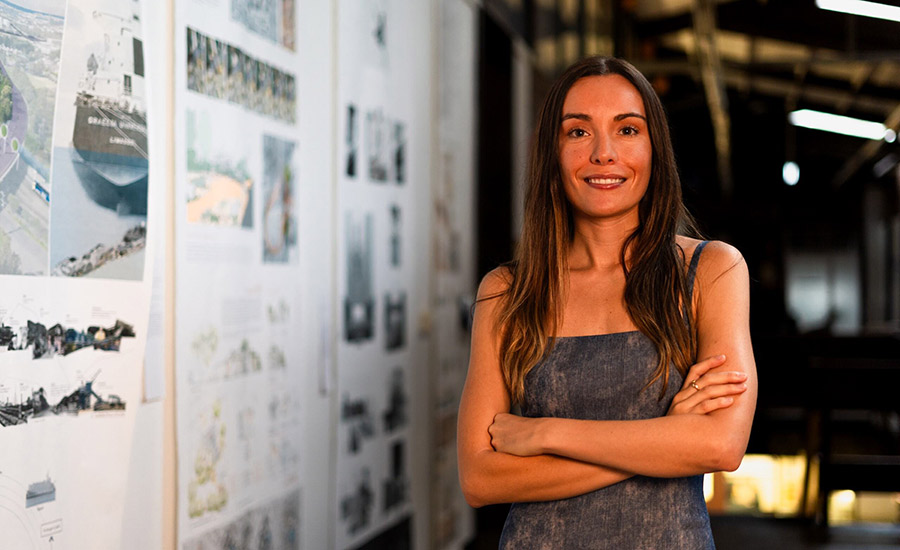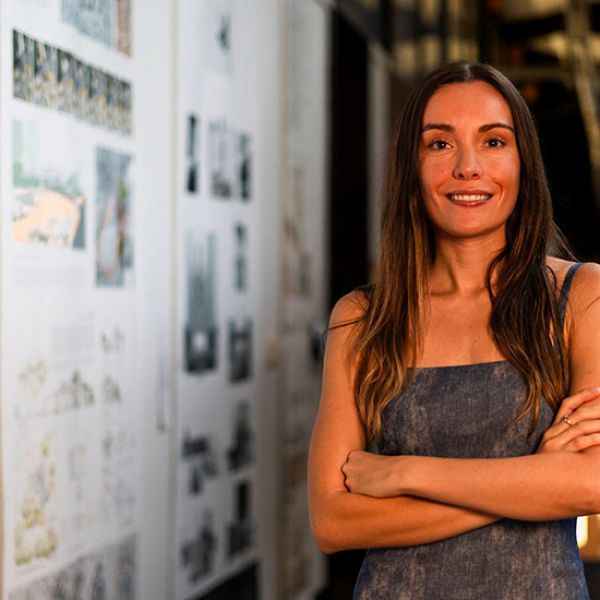Research that’s literally helping to build a better world
Miss Maria Cano Dominguez
Associate Lecturer Maria Cano Dominguez sees architecture as a political tool. Her curiosity about how architects influence education, politics and social systems is helping create a more sustainable, equitable, and resilient built environment.

Before joining the University of Newcastle as an Associate Lecturer – Maria was a tutor across different disciplines at the University of Technology Sydney, the University of Sydney and the University of New South Wales.
Before joining the academic path, she worked in industry for years, she is currently a Spanish Registered Architect. she was a project architect at Grupo Aranea in Spain, a design architect at BCHO Architects in South Korea, and a graduate architect at DVA in South Korea and at MHNDU in Australia.
Maria’s research dives into a modern trend where architects and thinkers are exploring new and unconventional approaches. They aren’t just designing buildings. They’re also questioning and revisiting major issues of our time. It’s a movement that stems from the anti-establishment counterculture of the 1960s.
“Western architectural culture has seen the emergence of theoretical, speculative, and subversive processes that have actively resisted significant contemporary events and systems such as capitalism, wars, extractivism, climate crisis, colonialism, and patriarchy”, explains Maria.
Through her research, she examines different practices by studying works and writings that were once overlooked but have played a crucial role in shaping today’s architectural knowledge.
Architecture as a political tool
In this line of thinking, architecture is much more than a building. It’s a political tool that influences our lifestyles, movements, relationships, ideologies and more—a relationship Maria hopes to highlight.
Her academic endeavours involve questioning and testing sustainable architectural strategies linked to experimental and radical propositions, departing from the Italian radicals of the 1960s and 70s and their ongoing legacy.
She investigates historical and political movements, architects and practices that influence our education, political and societal systems.
“One challenge is exploring and questioning dissensus (widespread dissent) within spaces and contemporary events and systems frequently forgotten or hidden by the discipline and their relationship with politics, society, culture and the environment,” says Maria.
Her research embraces new technologies and representation methods, from animations to projections and performances, and welcomes creative practices that explore non-conventional systems.
The why behind her work
Maria’s interest in this area of research stems from her curious nature. Throughout her education, she has never stopped asking ‘Why?
“I find myself studying and thinking critically about everything. I never take anything for granted and always try to understand the deeper historical connections and sides of a story”, shares Maria.
She goes on to explain that research is the first step of every project within academia and practice; there should always be an intention behind a new design, technology or writing.
This way of thinking is tethered to the ‘transscalarity’ meaning that a ‘house’ influences the people who live in it, their relatives and their future generations, but also the neighbourhood, the city or the country it’s in.
“It was this point of view, my curiosity, and also criticism that led to me getting involved in this field of research and pursuing a career as an educator.”
Collaborations equal impact
Working with national universities and academics across different disciplines who are interested in the same topics is essential to helping translate Maria’s research into actual impact.
Some of the universities Maria has partnered with include Escuela Tecnica Superior de Arquitectura de Madrid (UPM), the University of Alicante (UA), The University of Sydney (USYD), the University of Technology Sydney (UTS) and the University of New South Wales (UNSW).
Most recently, she’s developed collaborations through research and design projects with Grandeza Studio, Curious Practice, Studio Alura, Webber Architects, ELK Design, the City of Newcastle, Billard Leece Partnership, Trias Studio, Sibling Architecture, GM Architects, among others.
One of her high-level goals is to collaborate with hybrid multidisciplinary, multicultural researchers who are comfortable and active moving into a diverse range of competencies, methods, interests and questions.
Overcoming major issues of our time
So what real impact is Maria’s collaborative research actually having? How is it making a difference?
“By exploring and questioning dissensus in spaces, it’s helping us understand and address better political decisions and also environmental and cultural challenges”, says Maria.
By involving community members in the design and research process she’s ensuring that their needs, aspirations and cultural values are integrated into the built environment. This fosters a sense of ownership and pride in local projects questioning keywords such as community, ownership, capitalism, colonialism and heteropatriarchy.
Maria is also helping to come up with new systems and materials to reuse, recycle and repurpose through her exploration of sustainable and experimental strategies that minimise environmental impact and promote resilience.
In addition to this, by focusing on addressing social and climate imbalances in the built environment, such as access to affordable housing, wars, extractivism, and climate crisis, she’s helping to improve equity.
Last but not least, as an educator, and through the dissemination of research findings through publications, lectures, exhibitions and workshops, she’s empowering students, professionals, and community members with the knowledge and skills to effect a change in our society.
Ultimately, she hopes her work makes a difference to everyone who questions their past, present and future.
The path to change is never easy
Throughout her research, Maria has faced challenges.
One is the resistance she meets from people reluctant to face change—a common kickback when implementing new ideas or contesting traditional practices.
To overcome this, Maria has focused on building trust and fostering open dialogue with these people, demonstrating the research, case studies and writings and their importance.
Like most academic researchers, she’s also up against curriculum requirements and time constraints and has limited access to resources. All can hinder the exploration of interdisciplinary topics or real-world applications.
Her solution to this challenge has been to integrate experiential learning opportunities, such as design-build projects, internships, and community-engaged research, into the curriculum, providing students with hands-on experiences that bridge theory and practice.
Collaborating with other disciplines and departments has also expanded the scope and impact of her research and teaching endeavours.
Building a better world
Maria takes pride in developing research-driven solutions that address pressing challenges in the built environment and positively impact communities.
“Whether it's designing affordable housing prototypes, revitalising neglected urban spaces, or challenging capitalist and colonial design strategies, knowing that our work can improve people's lives but also make them aware of their role in our society gives my work purpose.”
Maria also enjoys pushing the boundaries of what’s possible in architecture. Whether it's experimenting with advanced computational tools for parametric design, investigating new materials and construction techniques, or integrating digital fabrication methods into the design process, it fuels her passion for research and training.
Maria finds motivation in her collaborations, which provide an opportunity to bridge disciplinary boundaries, exchange knowledge, and co-create solutions that address complex challenges.
As an educator, she finds it incredibly rewarding to empower the next generation of architects and designers to think critically, innovate, and make meaningful contributions to society.
“Overall, what excites me the most about my research is its potential to generate positive change, foster creativity and innovation, empower individuals and communities to shape a more sustainable, equitable, and resilient built environment, and create a safe space to be critical and rebel with current systems of power,” shares Maria.
Through her theoretical research, she’s literally helping to build a better world.
The University of Newcastle acknowledges the traditional custodians of the lands within our footprint areas: Awabakal, Darkinjung, Biripai, Worimi, Wonnarua, and Eora Nations. We also pay respect to the wisdom of our Elders past and present.
